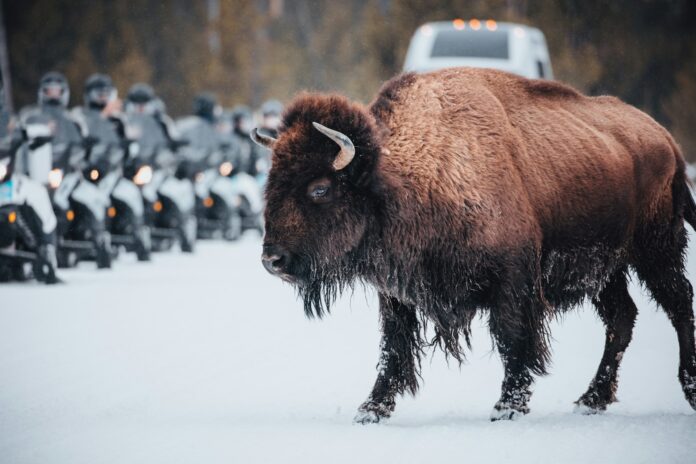Reintroduced European bison in Romania’s Țarcu mountains show potential for significant carbon sequestration, highlighting their role in climate crisis mitigation
A herd of 170 European bison reintroduced to Romania’s Țarcu mountains may help offset CO2 emissions equivalent to removing nearly 2 million cars from the road for a year. This finding underscores the potential of wildlife to mitigate the worst effects of the climate crisis.
European bison vanished from Romania over 200 years ago. However, since 2014, Rewilding Europe and WWF Romania have successfully reintroduced the species to the southern Carpathian mountains. This effort has grown the population to over 170 animals, making it one of the largest free-roaming bison populations in Europe. Researchers estimate the area could support 350-450 bison.
Embed from Getty ImagesThe recent study, funded by the Global Rewilding Alliance and conducted by scientists at the Yale School of the Environment, employed a new model to calculate the additional atmospheric CO2 captured and stored in soils through wildlife interactions. This study found that the bison grazing in nearly 50 square kilometers of grasslands within the Țarcu mountains could potentially capture an additional 2 million tonnes of carbon annually. This is nearly 9.8 times more than without the bison, equivalent to the yearly CO2 emissions of 1.88 million average US petrol cars.
Professor Oswald Schmitz of the Yale School of the Environment, the study’s lead author, explained the bison’s impact. “Bison influence grassland and forest ecosystems by grazing grasslands evenly, recycling nutrients to fertilize the soil, dispersing seeds to enrich the ecosystem, and compacting the soil to prevent stored carbon from being released,” Schmitz said. “These creatures evolved for millions of years with grassland and forest ecosystems. Their removal led to the release of vast amounts of carbon. Restoring these ecosystems can bring back balance, and ‘rewilded’ bison are climate heroes.”
Alexander Lees, a biodiversity expert at Manchester Metropolitan University, praised the study. He noted it provides a convincing case for European bison reintroduction as a nature-based climate solution, with significant biodiversity conservation benefits. Lees emphasized the need for more field research to validate the models and understand the timeline for bison benefits to materialize. He added that rewilding efforts and reintroductions are key tools in addressing biodiversity and climate crises.
Bison play a crucial role in ecosystems, maintaining a biodiverse landscape of forests, scrub, grasslands, and microhabitats through their grazing and browsing. In the Țarcu mountains, their presence has also inspired nature-based tourism and rewilding businesses. However, Schmitz noted that the specific soil and climate conditions of the Carpathian grasslands mean the impact of European bison might not be directly applicable to other regions, such as American prairies.
Magnus Sylvén, director of science policy practice at the Global Rewilding Alliance, highlighted the broader implications of the research. “This research opens up new options for climate policymakers worldwide,” Sylvén said. “Until now, nature protection and restoration has been seen as an additional challenge and cost alongside the climate emergency. This research shows we can address both challenges: rewilding can draw down vast amounts of carbon, helping to stabilize the global climate.”
The report on Romania’s European bison is the first of its kind, providing a powerful tool for guiding wildlife reintroductions. Schmitz and his team have studied nine species in detail, including tropical forest elephants, musk oxen, and sea otters, and are investigating others. “Many of them show similar promise to these bison, often doubling an ecosystem’s capacity to draw down and store carbon,” Schmitz added. “This is a policy option with massive potential.”
Analysis:
The reintroduction of European bison in Romania’s Țarcu mountains highlights the significant role wildlife can play in carbon sequestration and climate change mitigation. This study provides a comprehensive understanding of the ecological benefits of rewilding and its potential impact on global climate dynamics.
From an environmental perspective, the study underscores the importance of biodiversity in maintaining healthy ecosystems. Bison, as keystone species, help regulate vegetation, promote soil health, and prevent the release of stored carbon. This natural process complements technological and policy-based solutions to climate change, emphasizing the need for holistic approaches.
Economically, the findings suggest that investing in rewilding projects can yield substantial returns. By enhancing carbon sequestration, these projects can contribute to meeting international climate goals, potentially reducing the financial burden of climate mitigation strategies. Additionally, rewilding can stimulate local economies through ecotourism and related businesses, creating sustainable economic opportunities.
Sociologically, rewilding efforts can foster a greater connection between communities and their natural environment. The success of the bison reintroduction in Romania has already inspired local tourism and business ventures, highlighting the social and economic benefits of biodiversity conservation. Such projects can also raise awareness about the importance of protecting natural habitats and the species that inhabit them.
Politically, the study presents a compelling case for incorporating nature-based solutions into national and international climate policies. By demonstrating the carbon sequestration potential of rewilding, policymakers can make informed decisions that integrate conservation efforts with climate action plans. This approach aligns with global initiatives like the Paris Agreement, which seeks to limit global warming through comprehensive and collaborative efforts.
From a theoretical perspective, the study supports the growing consensus that large mammals play a crucial role in the carbon cycle. Rewilding, including the reintroduction of species like the European bison, represents a viable strategy for enhancing ecosystem resilience and carbon storage capacity. This aligns with ecological theories emphasizing the interconnectedness of species and their environments.
Overall, the reintroduction of European bison in Romania offers valuable insights into the potential of rewilding as a nature-based climate solution. By fostering healthy ecosystems and promoting biodiversity, rewilding projects can contribute significantly to global efforts to combat climate change and protect our planet’s future
